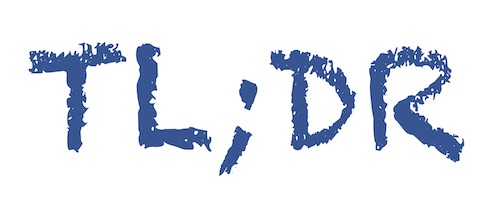Improve your business writing with the TL;DR principle

TL;DR is internet slang for “Too long, didn’t read.” The writer typically follows the letters “TL;DR” with a quick summary of the content of a long post. If you embrace the spirit of TL;DR properly, it can dramatically improve the quality of your writing.
Here’s how TL;DR works in the informal settings of sites like Tumblr or Facebook. A poster writes a bunch of paragraphs about something, then realizes that the length of what they wrote may put off some readers. So they go back to the top and write “TL;DR” and write a sentence that explains what they just wrote, intended for anyone who doesn’t have the patience to read the whole thing.
In its usual way, the popular internet has surfaced a fundamental truth about information: all of us are prone to overwriting, and none of us has time to plow through all that verbiage. TL;DR solves a universal problem. Here’s how you can use it to make your writing better.
Three ways to use TL;DR to serve readers better
Let’s suppose you have to write something informational — an email, a strategy memo, or a set of instructions, for example. Here’s how most people do that:
- Write a generic title, like “Product Rollout Strategy.”
- Write the document, starting with the first thing you think of and continuing through to a conclusion.
- After you’re done writing, feel like you rambled a bit. Also discover that what you really want to say is a bit different from what you started out saying.
- Feel vaguely unsatisfied.
I don’t want you to change a thing in that process. That’s how everyone writes. And yes, everyone, having created a first draft that way, feels like something is off.
This is the emotion that causes internet posters to create TL;DRs. You can put it to work. Your error is not the process you are using; it is that you stopped at step 4.
Here’s how to make what you wrote better:
5. Come up with a TL;DR for your piece — one sentence that best describes what you now realize you meant to say.
6. Use the TL;DR to rewrite the title (or subject line). For example: “For a successful Q4 product rollout, we must nail down the target market and media mix.”
7. Use the TL;DR to rewrite the first few sentences (the lede). For example: “Our project rollout will succeed if complete three tasks by August 1: refine the target market of aspirational millennials, develop a catchy brand identity, and plan the right mix of owned and bought marketing channels.”
8. Revise the full piece, focusing around the TL;DR you’ve discovered. Retain the parts that support that proposition; delete the rest. It may still be long, but maybe now it won’t be “too long.”
Why does this improve things? Because it focuses on the true meaning of what you are writing — the meaning that you only realize when you embrace the TL;DR idea. By forcing that meaning directly into the title and lead, you inform the reader up front what to expect. And by shaping the narrative around that meaning, you make the piece shorter, more pointed, less distracting, and easier to follow.
Stop beating yourself up for writing pieces that are too long and meandering. Just don’t stop there. Embrace the TL;DR principle to make them better instead.
Love this!
It’s so obvious – and yet so not obvious or more people would already be doing it (myself included).